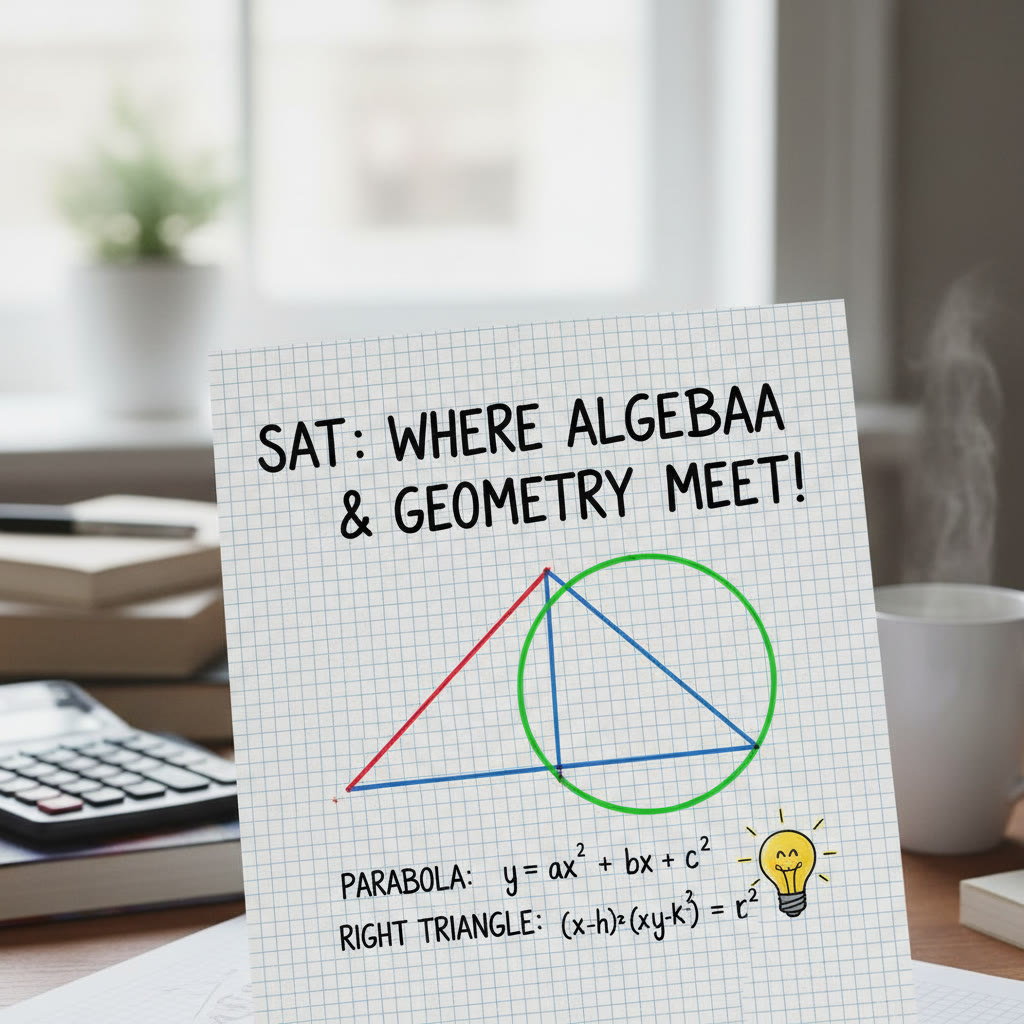Advanced Math Concepts That Sneak Into the SAT
There’s a little myth floating around that the SAT only tests basic math: simple algebra, a dash of geometry, and some number sense. The truth is friendlier and a bit more challenging. The SAT loves to disguise advanced, pre-calculus ideas inside compact, practical questions. That’s good news—once you recognize the disguises, you can prepare efficiently and demystify problems that looked intimidating at first.
In this piece we’ll unpack the advanced concepts that often appear on the SAT, show you crisp, concrete examples, compare strategies, and give a realistic study plan. Along the way I’ll mention how Sparkl’s personalized tutoring—one-on-one guidance, tailored study plans, expert tutors, and AI-driven insights—can help where it fits naturally. But first: breathe. These questions are never beyond reach; they just reward the right habits.

Why ‘Advanced’ Concepts Appear (and How the SAT Packages Them)
The SAT tests reasoning more than rote knowledge. So it frequently borrows advanced building blocks—functions, fractional exponents, trigonometric ratios, and absolute value reasoning—and asks you to combine them in straightforward contexts. The trick is not that the ideas are beyond high school; it’s how the test compresses them into short, high-leverage prompts that reward pattern recognition and strategic shortcuts.
Think of the SAT as a conversation: it asks a real-world question or sets a small puzzle, then nudges you to apply one or two deeper tools. Once you build a mental library of those tools, you’ll see many problems as friendly variants of patterns you’ve already mastered.
How to think about “advanced” on the SAT
- It’s usually applied, not theoretical: expect computations or simple proofs, not proofs by induction or multi-step derivations.
- Problems combine concepts: a quadratic inside a function evaluation, or a trig ratio inside a geometry setup.
- Shortcuts and structure: recognizing symmetry, substituting smartly, or spotting an identity often saves time.
Functions and Function Notation: The Most Useful “Advanced” Skill
Functions show up in many forms on the SAT: direct evaluation (f(3)), inverse relationships, composition (f(g(x))), and verbal descriptions (“the value of the function increases by 2 each time x increases by 1”). Being fluent with function notation and transformations pays off across topics.
Example: Composition without drama
Suppose f(x) = 2x + 1 and g(x) = x^2. Evaluate f(g(3)). A student who panics misses a straightforward two-step process: compute g(3) = 9, then f(9) = 19. Composition questions can look more complex when written algebraically, but the procedure stays the same: work from the inside out.
Tip: if you see nested functions, start with the innermost one and substitute. If a problem asks for f^(-1)(x), remember it’s the inverse function, not exponent notation.
Quadratics, Parabolas, and Smart Factoring
Quadratic equations and their graphs are a staple of the SAT. The advanced angle is how quadratics interact with other concepts—inequalities, systems, and function transformations. Strong algebraic manipulation skills plus an eye for completing the square or factoring quickly make many problems routine.
Example: A quadratic inequality that looks tricky
Consider: For what x does x^2 – 5x + 6 > 0? First factor: (x – 2)(x – 3) > 0. The product of two factors is positive when both are positive or both are negative. So x < 2 or x > 3. Visualizing the parabola opening upward helps: outside the roots it is above the x-axis.
Radicals and Fractional Exponents: Interpret, Don’t Panic
The SAT may require you to simplify expressions with square roots or fractional exponents, or to reason about radical equations. The key is fluency with basic rules: x^(1/2) = sqrt(x), x^(a/b) = (b-root of x)^a, and how to rationalize denominators when needed.
Example: A neat simplification
Simplify (x^(3/2))/(x^(1/2)). Use exponent rules: subtract exponents to get x^(1) = x. Problems like this are often quicker than they look because rules stack cleanly.
Trigonometry: Basic Ratios and Geometry Applications
The SAT won’t ask you to derive trig identities, but it will expect comfort with sine, cosine, tangent, and right triangle relationships. You’ll also encounter trig in geometry settings (e.g., finding heights or angles in coordinate setups) and occasional radian-degree conversions in straightforward contexts.
Example: Using trig in a real context
A tree casts a shadow 10 meters long and the angle of elevation to the top of the tree is 30 degrees. How tall is the tree? Use tangent: tan(30°) = height/10, so height = 10 * tan(30°) ≈ 10 * 0.577 = 5.77 meters. On the SAT, you don’t need exact decimal precision—recognize the setup, pick the required ratio, and compute or estimate sensibly.
Coordinate Geometry and Conic Sections: Circles, Lines, and Systems
Coordinate geometry connects algebra and geometry fluidly. Expect distance and midpoint formulas, slope and intercept reasoning, and sometimes circle equations (x – h)^2 + (y – k)^2 = r^2. The tricky part is translating a word problem into an equation quickly.
Example: Line and circle interaction
Given circle centered at (2, 1) with radius 3, does the point (5, 1) lie inside, on, or outside the circle? Compute distance from center: sqrt((5 – 2)^2 + (1 – 1)^2) = sqrt(9) = 3, so (5, 1) lies on the circle. These distance checks are often one or two computations—fast if you keep formulas at your fingertips.
Inequalities and Absolute Value: Two-Sided Thinking
Inequalities that combine absolute values or multiple regions test number-line thinking. The SAT tends to reward clear casework and visualization: rewrite |x – a| < b as a – b < x < a + b, or break |f(x)| = g into two linear cases when g ≥ 0.
Example: Absolute value in practice
Solve |2x – 4| ≤ 6. Rewrite as -6 ≤ 2x – 4 ≤ 6, then add 4: -2 ≤ 2x ≤ 10, divide: -1 ≤ x ≤ 5. Visualize this on a number line to avoid algebra mistakes.
Rational Expressions and Functions: Watch for Domains
Rational expressions often require attention to domain (values that make denominators zero) and simplification. The SAT might ask you to simplify an expression or solve an equation involving fractions. Keep factorization and cancellation rules ready, and always check for excluded values when solving equations—an often-overlooked trap.
Example: Cancelling with caution
Solve (x^2 – 4)/(x – 2) = 4. Factor numerator: ((x – 2)(x + 2))/(x – 2) = 4. Canceling gives x + 2 = 4, so x = 2. But x = 2 is excluded because it makes the original denominator zero. Hence no solution. This is exactly the kind of detail that separates a correct answer from a common mistake.
Sequences, Series, and Growth Patterns
Arithmetic and geometric sequences can appear in algebraic or word-problem form. You might be asked for the nth term, a sum, or recognition that a process grows exponentially. Again: the SAT keeps these basic and applied—no infinite series convergence tests—so practice pattern recognition.
Example: Geometric sequence quick check
If a sequence is 3, 6, 12, 24, … its common ratio is 2 and the nth term is 3 * 2^(n-1). If a problem asks for the 6th term, compute 3 * 2^5 = 96. Keep powers of 2 and basic power arithmetic handy.
Probability and Data Analysis: Clear Logic Over Heavy Computation
These problems favor careful enumeration, complementary counting, and ratio thinking. The CAS (Calculator) and non-calculator portions will require both mental techniques and accurate arithmetic where necessary. Watch for conditional phrasing—“at least,” “at most,” and “without replacement” all change the structure of the solution.
Example: Complementary probability
What is the probability of getting at least one heads in two fair coin flips? Easier to compute the complement: probability of zero heads (both tails) = 1/4, so at least one head = 1 – 1/4 = 3/4.
Practical Strategies: How to Spot the Advanced Tricks Quickly
Beyond content, the SAT is about pattern recognition and time management. Here are tactical moves that turn intimidating advanced questions into routine work.
- Scan for structure: factorable quadratics, difference of squares, or perfect squares are often hiding behind messy expressions.
- Substitute numbers: when algebraic manipulation feels long, plug in convenient numbers (often small integers) to test statements or compare choices. Make sure substitution preserves domain and uniqueness.
- Work backwards from answer choices: especially useful on multiple-choice questions where algebra is messy but choices are simple.
- Use a graphing habit mentally: sketch a parabola or line to see intersection counts or inequality regions. A rough sketch is often enough.
- Manage domain traps: when you cancel factors or divide by expressions, check excluded values explicitly.
Example Walkthrough: Combining Multiple Concepts
Problem: Let f(x) = x^2 – 4 and g(x) = sqrt(x + 4). For what x is f(g(x)) defined and equal to 5? First, understand domain: g(x) requires x + 4 ≥ 0, so x ≥ -4. Next compute inside out: g(x) = sqrt(x + 4). Then f(g(x)) = (sqrt(x + 4))^2 – 4 = (x + 4) – 4 = x. So f(g(x)) = x. We want x = 5, and check domain: 5 ≥ -4, so x = 5 is valid. Observations: composition simplified dramatically because squaring a square root neutralized each other—spotting that early saves algebra.
Study Plan Table: How Much Time to Spend on Each Advanced Topic
| Topic | Why it matters | Weekly practice (hours) |
|---|---|---|
| Functions & Composition | Appears across problem types; builds fluency | 3 |
| Quadratics & Parabolas | Foundational for equations and graphs | 3 |
| Radicals & Exponents | Common simplifications and domain issues | 2 |
| Trigonometry | Right-triangle problems and coordinate geometry | 2 |
| Rational expressions | Careful cancellation and excluded values | 2 |
| Coordinate geometry & circles | Combines algebra and geometry | 2 |
| Probability & Data | Word problems and logical reasoning | 2 |
This table is a practical guideline for a focused month of study. If you’re already strong in one area, reallocate time to weaker spots. Quality matters more than total hours—combine problem sets with targeted review and varied difficulty.
Practice Techniques That Build Transferable Skill
Practice is not only about quantity. Deliberate practice means isolating the cognitive load and then increasing complexity. Here are methods that work especially well for the advanced things the SAT hides in plain sight.
- Interleaved practice: mix topics in every practice set so your brain learns to choose the right tool, not just repeat a procedure.
- Error logs: record why you missed a problem—conceptual gap, careless arithmetic, or time pressure—and address that type specifically.
- Timed mini-sessions: simulate real SAT pacing in short bursts (15–20 minutes) focusing on targeted topics to build automaticity.
- Explain aloud: teach a problem or solution to a friend or to yourself; explaining forces clarity and deeper understanding.
How Personalized Tutoring Helps (When It Fits Naturally)
Advanced concepts are often less about raw knowledge and more about application and pattern recognition. That’s where personalized tutoring can accelerate progress. With one-on-one guidance, a tutor can diagnose whether you need more modeling with functions, quicker factoring skills, or confidence with trig setup. A tailored study plan prevents wasted time and keeps practice deliberately targeted. AI-driven insights—when used as a supplement—can highlight patterns in your mistakes so tutoring sessions attack the real bottlenecks.
If you choose a service like Sparkl, for example, expect focused sessions that blend expert tutors with individualized pacing, practice that targets your unique weak spots, and data-driven feedback so you improve faster than with generic study alone. It’s not about removing effort—it’s about directing it where it produces the largest gains.
Common Pitfalls and How to Avoid Them
- Rushing algebra: Algebraic manipulation is often the slow step. Slow down just enough to avoid sign errors and bad cancellations.
- Ignoring domain: Cancelling factors without checking excluded values is a frequent trap on rational problems.
- Miscalculating trig: Use exact values when possible (like tan(30°) = 1/√3) and estimate cleanly when decimals are acceptable.
- Overcomplicating composition: If a composition simplifies algebraically (like a square undoing a square root), notice it early.
Final Thoughts: Confidence Through Pattern Recognition
Advanced math on the SAT isn’t a separate beast; it’s the same mathematical language applied thoughtfully. Each concept—functions, radicals, quadratics, trig, coordinate geometry—turns up in small doses. Your job is to recognize the dose, pick the right tool, and apply it efficiently.
Build that skill with targeted practice, honest error analysis, and a study plan that emphasizes patterns over memorization. If you want more acceleration, consider one-on-one work: an expert tutor can give immediate feedback on signs, domain traps, and structure recognition, while AI-driven insights can highlight recurring error patterns tailored to your profile.

Above all: keep a curious mindset. Advanced ideas lose their sting when you practice them in small, consistent doses and see how often they reappear in slightly different forms. With the right approach—clear strategies, deliberate practice, and targeted help when you need it—you’ll stop being surprised by the SAT and start enjoying the clever puzzles it offers.
Good luck, and remember: every problem you untangle builds both skill and confidence. If you want a tailored roadmap for the specific advanced topics you keep missing, a few targeted tutoring sessions can save you weeks of wandering. Study smart, practice deliberately, and let pattern recognition do the heavy lifting.





















No Comments
Leave a comment Cancel